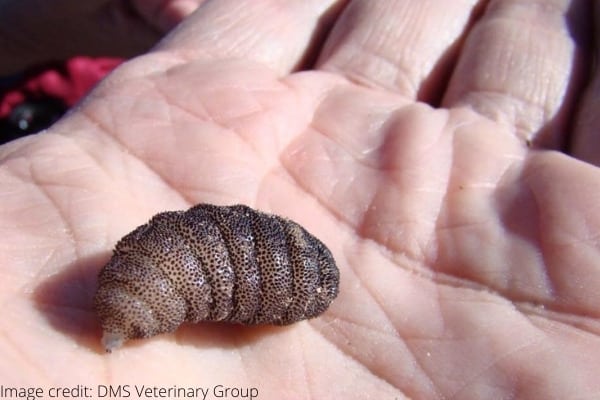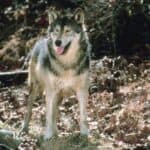
Dogs can suffer from different types of parasitic infestations, and one of the most common and most bothersome is botfly infestations.
Botfly larvae can burrow down into a dog’s skin and cause pain, itching, and infections.
How do I know if my dog has a wolf worm? A wolf worm will most often cause a small lump or swelling under the surface of the skin. The area will be irritated and itchy, and there will be a visible hole in the center of the lump that allows the larva to breath. The best way to diagnose a wolf worm is to have the area examined by a vet.
If your dog has a parasite or strange lump and you want to know if it could be a wolf worm, read on to learn more about this type of parasite.
What Are Wolf Worms?
Wolf worms are larvae that are transmitted to dogs by botflies. They are parasitic and burrow down into the skin of a dog and can cause pain and dangerous infections.
Botflies lay eggs on the body of a dog or another animal or on blades of grass, often in the vicinity of rodents and rabbits.
When the unsuspecting dog comes in contact with the larvae, the tiny maggot-like creatures burrow under the skin.
Wolf worms are different than the dreaded mango worms, but they can be equally disgusting and dangerous if not treated.
What Do Wolf Worms Turn Into?
Wolf worms are the larvae of botflies. The botfly lays its eggs on the body of the dog, and when the eggs hatch, the larvae dig into the dog’s skin, where they mature and turn into wolf worms.
The worms continue to develop in the dog’s body, and if left untreated, they can cause severe infections.
Wolf Worm Life Cycle
Wolf worms have a very interesting life cycle. They start out as eggs that are laid by a botfly and then turn into larvae about 12 to 21 hours later.
The larvae feed on skin cells and blood within the surface of the skin.
When the larvae are mature and ready to pupate, they will exist their warble (the hole that they created in the animal’s body) and fall to ground, where they form a pupa.
After the pupation period, an adult botfly will emerge, and the cycle will begin again.
Where Are Cuterebra Found?
Cuterebra is a type of botfly that can cause a parasitic infection called cuterebriasis.
They are found in North America and South America and are spread by botflies (in some cases mosquitoes too).
They are found on the fur and bodies of cats, dogs, and other mammals. They are often found on the neck, ears, mouth, nose, and near other openings on the body.
Can Humans Get Wolf Worms?
Humans can get wolf worms the same way dogs and other animals get them. If an adult bot fly lays its egg on a person’s skin or comes into contact with larvae, they may indeed develop a warble.
How Do Dogs Get Wolf Worms?
There are many ways dogs can get wolf worms, and this type of infection is very common in many different dog breeds. Dogs can get wolf worms from:
- Adult bot flies laying eggs on the dog.
- Mosquitoes transmit the larvae of bot flies to a dog’s skin through their bites.
- Swallowing bot fly larvae.
- Bot fly larvae brushing off onto a dog’s skin from the environment
How Big Do Wolf Worms Get?
Wolf worms are not very big, but they can do a lot of damage. They usually only grow to be about half the size of a dime.
The adult version of wolf worms are botflies, and they grow to be about the size of a horsefly or bee.

Are Warbles Harmful to Dogs?
In many cases, warbles are not a cause for concern. The warbles themselves do not do much harm but may irritate the dog or even be painful.
If the dog bites or scratches at the warble site, it could cause the area to become infected, which can be harmful and even fatal in some cases for dogs.
Can Wolf Worms Kill a Dog?
Wolf worms themselves are not harmful, but they can lead to serious skin infections that could be fatal in dogs.
Do Warbles Go Away?
Cuterebra will eventually develop to the point that they will leave their host to pupate in the soil. This may take between 3 and 6 weeks.
The area should be disinfected once the larva is gone, and antibiotics may be necesssary.
How Do I Know if My Dog Has Wolf Worms?
It can sometimes be hard to tell if your dog has a wolf worm infestation. The best way to identify the type of infestation your dog has is to schedule an appointment with your veterinarian.
The vet will be able to check out your dog, inspect the worm or warble, and remove it. The veterinarian will also treat any infections that may result from the wolf worm.
Wolf Worm Symptoms & Identification
There are many different signs of wolf worm infections in dogs. Not all dogs will demonstrate the same symptoms. Some common signs include:
- A lump or swelling in the dog’s skin with a small hole in the center (breathing hole)
- Redness at the site
- Sneezing (if within the nasal area)
- Swollen eyes, leaking fluid squinting eyes (if in the eye region)
- Puss oozing from the skin
- Scratching
Can I Remove a Warble From My Dog?
Removing a warble from your dog on your own is not a good idea. A piece of the larva could break off and stay inside the dog, causing more problems.
It’s best to schedule an appointment with your veterinarian to have the warble removed, have any infections or skin problems treated, and to have the hole cleansed.
What Happens if Cuterebra Is Not Removed
If a cuterebra is not removed, it will come out of the dog’s skin on its own in about 30 days. When it emerges, it will drop to the ground and transition to the pupal phase.
How To Get Rid of a Botfly in a Dog
The best way to remove a botfly larva from a dog’s skin is to cover the hole the larvae made with petroleum jelly.
This prevents any air from getting to the larva and forces it to come to the surface. Then it can be removed from the dog safely.
You can also take the dog to a veterinarian to have the botfly removed safely and to ensure there are no other infections.
How To Prevent Botflies in Dogs
While botfly infections are common, there are some things you can do to protect your dog from these pests.
- Keep your dog away from rodents
- Keep your dog away from animal dens
- Bathe your dog often
- Apply insect repellent to your dog every time he goes outside
- Inspect your dog for signs of eggs or larvae
Final Thoughts
Wolf worms are a common problem for many dogs.
If you suspect your dog may have wolf worms, make an appointment with a veterinarian to have the worm removed and ensure there is no infection present.
You can protect your dog from wolf worms by applying insect repellent any time he goes outdoors.
Image credits: Puppy Love Pet Grooming, DMS Veterinary Group




